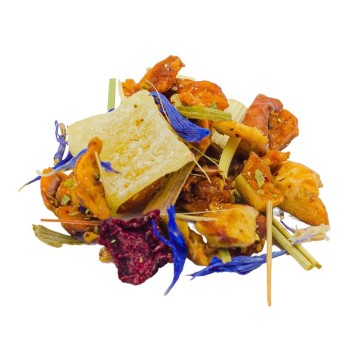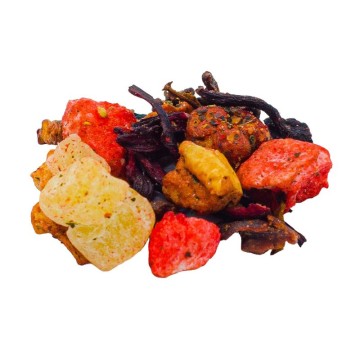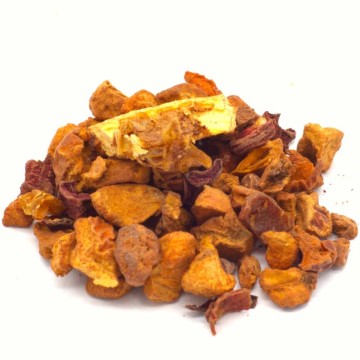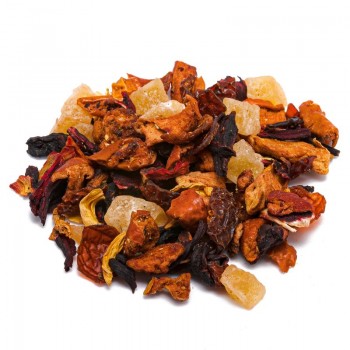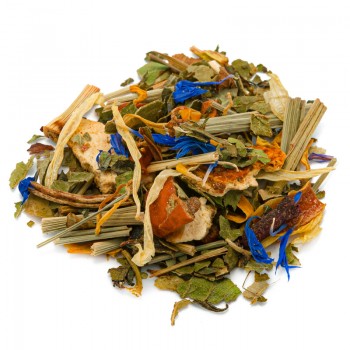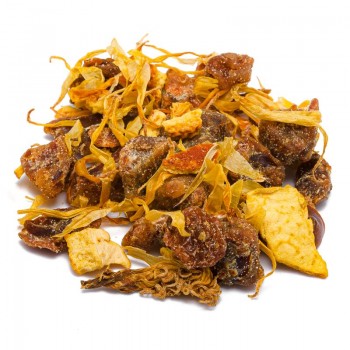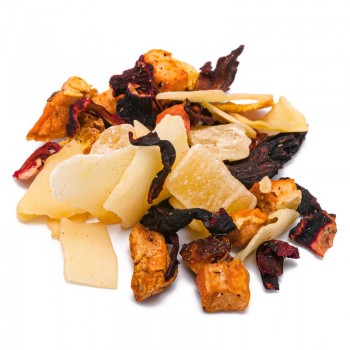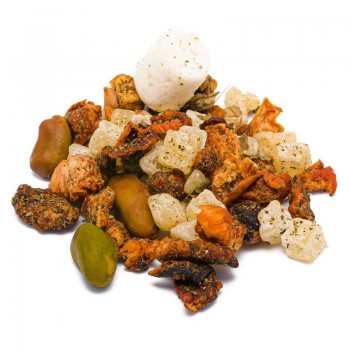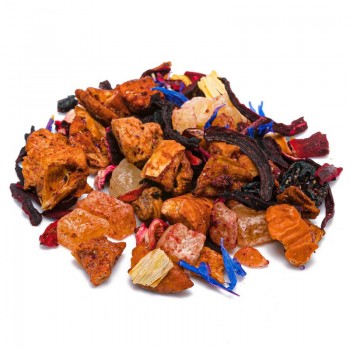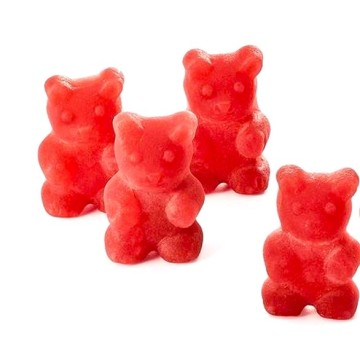Between fruit and spices, this infusion blend ensures a delicate taste and an enveloping aroma. A spicy adventure that starts with the soft flavor of hibiscus and the warm and pungent sensation of cinnamon, cardamom and cloves. They balance the fruity and tart notes of rosehip and apple, and add the floral notes of rose petals. The touch of ginger and black pepper makes this drink slightly and pleasantly pungent. The final notes between walnut and popcorn create a substantial and tasty blend. Overall, the flavor is reminiscent of autumn fruit, enlivened by sweet and pungent spicy notes, with a sweet and exotic hint of cinnamon.
Mandarin and cinnamon infusion: properties and benefits
The hints of cardamom, which emerge from the lively ginger, are not only a spicy pleasure but also give useful properties to our body. By taking this infusion, we can find the taste and properties of various spices. Cinnamon has beneficial properties for our body, due to its high digestive power - in ancient times it was already used in Ayurvedic medicine to treat indigestion and gastrointestinal disorders. It facilitates the assimilation of food, regulates intestinal transit and counteracts the formation of gas, with the consequent abdominal swelling.
Its astringent and purifying qualities are useful in the hot drink also to treat colds together with other spices in which it is necessary to free the nose and throat from excess mucus; as well as for irritations of the oral cavity. In the mixture, cardamom enhances the digestive properties of cinnamon, against stomach acidity and abdominal swelling.
It is one of the most prized spices with a balsamic aroma, which combines with cinnamon and ginger to combat nose and throat irritation. In particular, ginger is considered a natural remedy for gastrointestinal disorders, and when combined with other spices it stimulates correct digestion. The hearty, spicy blend can provide relief from feelings of nausea and bloating, especially as a hot infusion. Among other elements, the benefits of hibiscus and apple for digestion and the regularity of intestinal transit are also known; hibiscus has detox and diuretic properties. Together with cinnamon it promotes the drainage of excess body fluids. Together with hibiscus, rosehip provides vitamin C to the infusion and promotes diuretic and laxative actions - ideal for those who suffer from constipation or want to combat water retention.
Origins and history of cultivation
Cinnamon is one of the oldest spices in the world, known for centuries in the Indian subcontinent, where it comes from. In particular, cinnamon from the island of Ceylon (now Sri Lanka) is known, called true cinnamon compared to other similar plants and spices. Today the cinnamon plant grows throughout much of southern and southeastern Asia, as well as the territories of Madagascar and the Seychelles Islands. It was discovered by obtaining the spice from the inner part of the bark of the Cinnamomum tree. The dried bark curls, creating the cinnamon stick structure. We usually find it in powder form, which comes from grinding the sticks. Culturally, it is an essential spice in the Indian Ayurvedic tradition, then used in 3000 BC. as a perfume for embalming among the ancient Egyptians.
It has always been considered a precious spice in the Middle East, prized for its warm, sweet flavor. In traditional Ayurvedic medicine, it has been used in the past to treat digestive disorders, bronchitis and problems of the urogenital tract. It arrived in Europe via Arab traders and was highly appreciated by the Greeks and Romans for its ability to preserve meat and some foods. It was very expensive, as it was transported overland via caravans. As a status symbol in Europe, it was used in the kitchen by the chefs of rulers and nobles, often combined with pepper, to flavor game and desserts.
With the era of geographical discoveries, it was spread by explorers (Dutch, English and French) and introduced in the eighteenth century to many islands and tropical and subtropical areas. Over time, cinnamon has become increasingly widespread, and in the 19th century it was included in the 4 main spices of recipes for flavouring: cinnamon, pepper, nutmeg and cloves.
Fruits and flowers
The botanical name of the cinnamon tree is Cinnamomum zeylanicum. It is an evergreen tree of the Lauraceae family, with a high barkand aromatic properties. The cinnamon tree grows in moist, well-drained soil, and reaches about 15 meters in height. It shows oval leaves and small flowers with greenish to yellow colors; the fruit is a dark drupe. Among the species related to Ceylon cinnamon, others are cultivated as a source of the spice, including Chinese cassia (Cinnamomum cassia), Vietnamese cinnamon (C. loureiroi), Indonesian cinnamon (C. burmannii), and Malabar cinnamon (C. citriodorum). Ginger is the spice that comes from the rhizome or root of the herbaceous plant Zingiber officinalis. It grows for about a meter, developing the underground rhizome, from which the flowers with pale yellow petals arise on the shoots. Ginger plants are tropical, preferring high humidity and high temperatures, moist, rich soil. Cloves are the dried flower buds of the Eugenia caryophyllata (or Syzygium aromaticum) plant.
Belonging to the Myrtaceae family, it is a plant native to Indonesia. Cloves represent a spice, and have nothing to do with the clove plant. The cardamom spice comes from the pods of the tropical plant Elettaria Cardamomum, belonging to the Zingiberaceae family. Originally from India, it shows a pod or capsule that contains several seeds, small and dark: it is they that give the aroma of cardamom when they are dissolved or ground. There are also black (Nepali) cardamom, obtained from the Amonum Subulatum plant, brown-brown cardamom and delicate white cardamom. The hibiscus plant is Hibiscus sabdariffa, belonging to the Malvaceae family. Probably native to West Africa, it gives the colored flowers from which, by drying the glasses, infusions and drinks known as hibiscus tea and bissap are obtained.
The Rose is a perennial plant of the Rosaceae family. There are over three hundred species and thousands of cultivars of this plant, famous for its flowers. They change in shape, size and color from white to yellow and red. Most species are native to Asia, and the Rosa canina variety produces a fruit called rosehip. The Malus domestica plant of the Rosaceae family gives us apples. It is a tree native to Asia, now widespread throughout the planet. The fruits vary in color and in many varieties, and have been used in human nutrition for millennia.
Nutritional values of mandarin and cinnamon infusion
The main active ingredients are vitamin C, cinnamon cinnamaldehyde, ginger compounds (zingiberene, polyphenols gingerols and shogaols), other antioxidant polyphenols and tannins. Among the minerals it contains manganese, zinc, copper.
How to use the ingredients in the infusion
You can obtain the infusion by placing approximately 3-5 grams of the mixture in a cup (250 ml), with water at a temperature of 100 °C. Leave to infuse for 10 to 12 minutes before drinking the mandarin and cinnamon infusion. Add honey or sugar, if desired.
Mandarin and cinnamon infusion: side effects and contraindications
It is necessary to respect the recommended doses and not exceed the consumption of the infusion for too long periods. Excessive intake can cause diarrhea, headache, digestive and gastrointestinal disorders. Caution advised for pregnant or breastfeeding women.

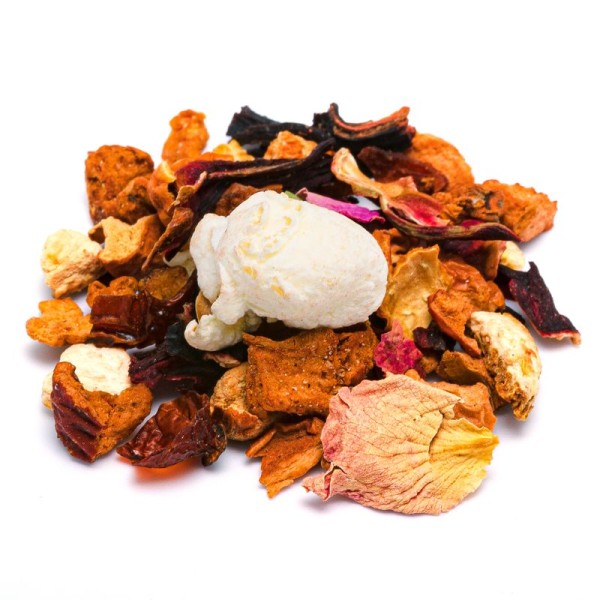









 No reward points for this product.
No reward points for this product.
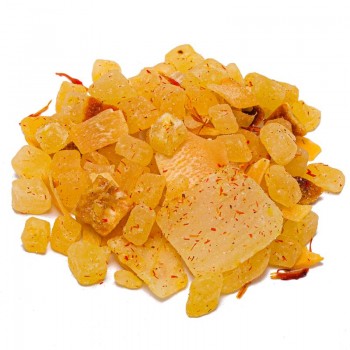
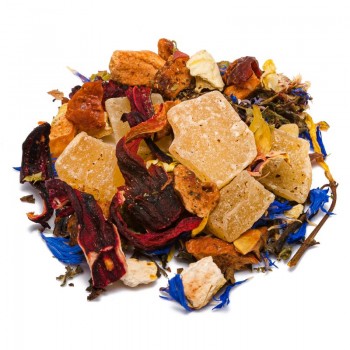
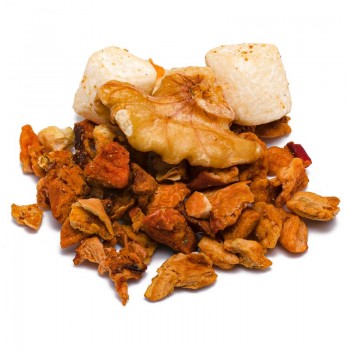
![infuso pesca e vaniglia [Natura d'Oriente]](https://www.naturadoriente.com/3538-home_default/infused-peach-vanilla.jpg)
